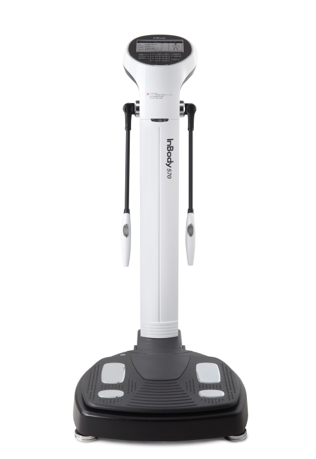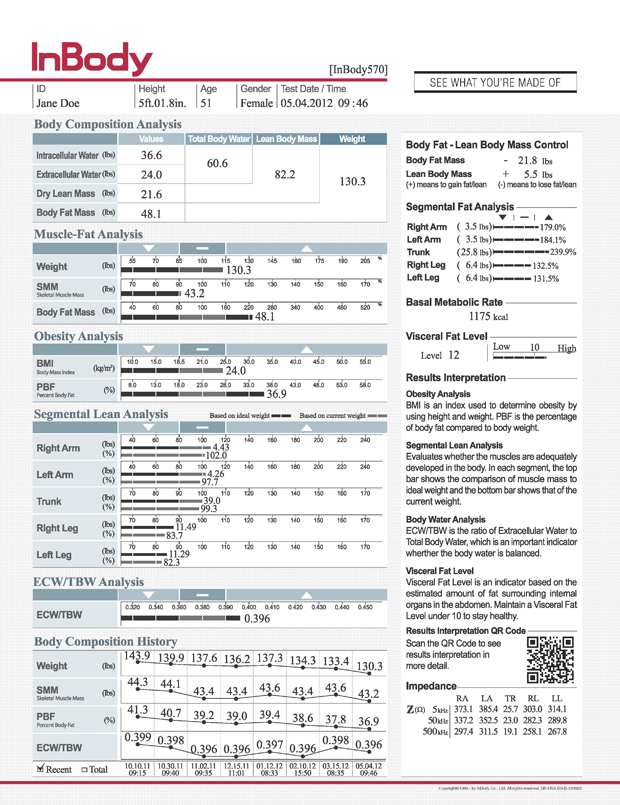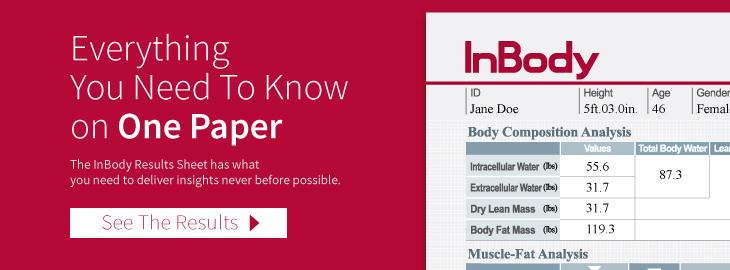Body Composition Testing
The InBody 570 is state-of-the-art technology that we are excited to have at RZone FITNESS as it enables us to look beyond the number on the scale and show you what your body is really made of.
The InBody has revolutionized the field of Body Composition Analysis, and currently is the most advanced product in the market using patented Direct Segmental Multi-Frequency 8-Point Tactile technology. With a 98% correlation with gold standard body composition methods such as DEXA, the InBody is used by top hospitals, gyms and sports teams because of its accuracy.
By simply standing on the InBody for 60 seconds it allows for a quick and non-invasive test that presents a printed full page color result sheet (see example below) that provides users with their Body Fat Percentage, Basal Metabolic Rate, Segmental Muscle Balance, water distribution within the body, progress graphs, and personal previous measurements.This will include a full report (see below for sample).
The 30-minute session includes the assessment and interpretation of results with a RZone FITNESS Expert.
Non-RZone Clients: $50.00
The Consultations take an average of 20 to 30 minutes.
Following are important steps to take prior to completing your InBody Test:
- Consistent amount of hydration the day before.
- Do not drink caffeine on the day of your test.
- Do not eat for 3-4 hours prior to testing.
- Do not exercise 6-12 hours prior to testing.
- Do not consume alcohol 24 hours prior to testing.
- Do not take InBody test after shower or sauna.
- Remove jewelry, socks, pantyhose, and shoes.
- Do not use lotion or ointment on hands or feet.
- Stand for at least 5 minutes prior to testing.
- For females, avoid testing when pregnant or during menstruation.
- Individuals with pacemakers or other electronic medical devices should not take the InBody Test.
If you are interested in the body composition analysis, Please fill out the form at the bottom of the page.
The greatest feature of the InBody is being able to track the right kind of weight loss. A client that comes in at 8 pounds lighter in one week, may find out they lost 6 pounds of water and 2 pounds of muscle. This really helps us stress the importance of proper nutrition, resistance training, productive cardio training and supplementation.



8 Point Tactile Electrode Method
When measuring impedance with electrodes, contact resistance invariably occurs. Controlling contact resistance is essential in order to accurately measure impedance in the body. InBody accounts for contact resistance by using a unique method of electrode placement. The 8-Point Tactile Electrode Method separates the current and voltage electrodes so that measurements always begin at a fixed point in the wrists and ankles. This provides high reproducibility and correct body impedance measurements because variability due to contact resistance from the skin has been removed. The use of a separated voltage thumb electrode is patented InBody technology that makes InBody devices unique in the BIA industryMultiple Frequencies
Electric currents have differing penetration abilities depending on their frequency. Some frequencies are better suited for measuring body water outside the cell, while others are capable of passing through cell membranes and measuring total body water. InBody makes use of multiple currents at varying frequencies in order to provide most precise body water analysis results. Currents with higher frequencies can determine the water content inside the cell because they can penetrate the cell membrane. Conversely, currents with lower frequencies have limited abilities in penetrating cell membranes and will follow the path of least resistance by traveling around them, making them suitable for measuring the water outside the cells.Direct Segmental Multi-frequency Bioelectrical Impedance Analysis
Modern BIA views the human body as five “cylinders”: the arms, the legs, and the trunk. Accurate and independent measurements of each cylinder are essential for providing analysis not just for each cylinder, but for the entire body. InBody’s advanced technology allows all InBody devices to directly measure all five cylinders. Direct Segmental Multi-frequency Bioelectrical Impedance Analysis (DSM-BIA), InBody’s signature technology, separately measures the impedance of the arms, legs, and trunk. Although accurate impedance measurement of each cylinder is critical for reliable results, the most important measurement is trunk impedance.No Empirical Estimations
Empirical data, such as data related to age and gender, are values that are achieved through observation. Estimations that use empirical data have been used to improve the accuracy in BIA devices that measure impedance using the Whole Body Impedance method. Although useful for measuring the typical and/or healthy body type, problems occur when measuring individuals that have atypical body types, such as high performance athletes or severely overweight individuals. InBody avoids this problem altogether by completely avoiding any use of empirical estimations. Because InBody’s advanced technology allows for the direct and precise measurement of each of the body’s five segments, including the trunk, InBody devices do not require or take into account any empirical data when producing results. It is unnecessary. The only information InBody requires to determine body composition are height, weight, and impedance. This makes InBody suitable for testing atypical body types. InBody always provides correct results regardless of gender, age, or race. If an individual tests on an InBody device, and immediately re-tests with a different age or gender, that individual will receive the same results on their second test as they did the first.Q and A
- The use of multiple frequencies to accurately measure intracellular AND extracellular water
- 8-point tactile electrodes providing a direct and reproducible measurement
- Segmental impedance measurements – to include accurate lean body mass measurements of the trunk
- No empirical estimations required. No population-based statistical data is used in calculating results.
- Pre-printed, colorful results sheets
